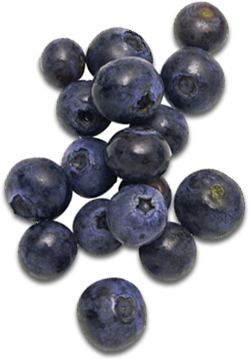no items to display
Purple is showing up in all kind of places it didn’t used to. These days, you can find purple asparagus, carrots, cauliflower, corn, kale, and sweet potatoes at farmers’ markets and grocery stores.
These pretty hues aren’t just a way to add a splash of color to your stir-fries, though. Foods with deep purple pigments — such as beets, black cherries, blackberries, blueberries, eggplant, elderberries, plums, pomegranate, red grapes, and red cabbage — are nutritionally dense and full of anthocyanins, antioxidant compounds linked to cognitive function, cardiovascular health, a desirable weight, and even longevity.[1],[2] It’s no wonder that late last year, Whole Foods Market named purple foods as one the top ten food trends to watch in 2017! Let’s look at two of our favorite purple fruits:
Grapes
Red grapes (which are really more purple than red) contain resveratrol, the phytonutrient that gives wine its heart-healthy reputation. In addition, a one-cup serving of fresh red grapes provides[3]:
- 28 percent of the Daily Value (DV) for vitamin K, which is necessary for healthy blood coagulation and the metabolism of calcium
- 27 percent of the DV for vitamin C, which aids immune function and is needed for the health of connective tissue
- 10 percent of the DV for copper, which helps the body absorb iron and plays a role in energy production
- 1.4 grams of fiber, which is necessary for normal digestion and elimination and reduces the risk of heart disease
- Just 104 calories!
Sweet, juicy grapes are refreshing on hot summer days, either alone or in a fruit salad!
Elderberries
Elderberries can be harder to find than grapes, but they are a highly nutritious berry and are thought to be an immune booster. A one-cup serving of fresh elderberries provides[4]:
- 87 percent of the DV for vitamin C
- 17 percent of the DV for vitamin A, necessary for healthy vision, immune strength, and the integrity of skin and mucous membranes
- 17 percent of the DV for vitamin B6, which helps regulate mood and sleep
- 13 percent of the DV for iron, which helps the body maintain normal energy levels
- 12 percent of the DV for potassium, an electrolyte that maintains fluid balance in cells and is critical to a healthy heart
- An impressive 10.2 grams of fiber
- Only 106 calories!
Elderberries are most often eaten cooked, though some people like them raw.
What are your favorite purple foods? Share in the comments below!
References
[1] Lienard S. What are anthocyanins and why are purple foods so healthy? BBC Good Foods blog. 2017 Mar 13. https://www.bbcgoodfood.com/howto/guide/what-are-anthocyanins-and-why-are-purple-foods-so-healthy
[2] Blue and purple foods for better health. Eating Well. http://www.eatingwell.com/nutrition_health/nutrition_news_information/blue_and_purple_foods_for_better_health
[3] Grapes, red or green (European type, such as Thompson seedless), raw Nutrition Facts & Calories. http://nutritiondata.self.com/facts/fruits-and-fruit-juices/1920/2
[4] Elderberries, raw Nutrition Facts & Calories. http://nutritiondata.self.com/facts/fruits-and-fruit-juices/1883/2






